Every time it's my turn to write a blog post I can't help but feel mystified by a technique that I've learned while here at Dartmouth. 'But Beth,' I hear your cry, 'how can there really be something that amazing every month?!' I promise you, I can explain no further than 'there just is!'
This month's new trick of the trade is something I love to tell my friends and family about because it makes their jaws drop. It made mine drop too, the first time I saw this done! Washing paper. That's right, dear readers, I've spent numerous hours this week scrubbing 1800's dirt and grit out of the pores of paper. Now don't get me wrong, this isn't for all paper. We spent a lot of time making sure the ink wasn't going to bleed or run or act strange when introduced to water and here in Dartmouth's Preservation Services, we have a SUPER WATER FILTER that removes everything except two atoms of hydrogen and one of oxygen, I'm talking about H2O, ladies and gentlemen.
A quick word of caution: The following conservation treatment was performed under the direction of a trained conservator. Please do not attempt to put valuable paper materials in a bath without guidance from an expert. If you want to practice this nifty process, we ask that you use discarded items such as yesterday's newspaper. For treatment of artwork, historical materials, or treasured family documents, please consult a qualified conservation professional. Thanks! Now back to the post...
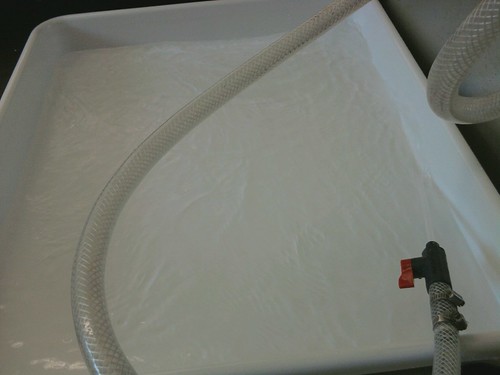
There is something oh-so-strange about dipping and submerging a piece of newsprint paper from 1800's in a bath of water, but you get used to it! This particular volume had a lot of glue and over-sewing so when we took it out of its binding, it wouldn't lay flat! After some deliberation, Deborah Howe (Conservator) decided that the fastest and safest way to remove all the glue would be to wash each folio. And that's where I come in!
Before I can start introducing paper to water, I have to make sure everything is ready to go to assembly-line the process. With a lot of glue to clean off, the more streamline the easier it is on me and my schedule! So that being said, I draw up a bath of the filtered water, and introduce a little bit of Isopropyl alcohol. The Isopropyl will help open the pores of the newsprint up so that the water can get in and the dirt can get out. Then I fill up a kettle of just the filtered water and heat it up just below boiling and pour that into the bath until the bath is more warm than it is cold. The heat just helps the glue loosen up faster. I mean, come on, I don't have all day to be scrubbin' this paper down.
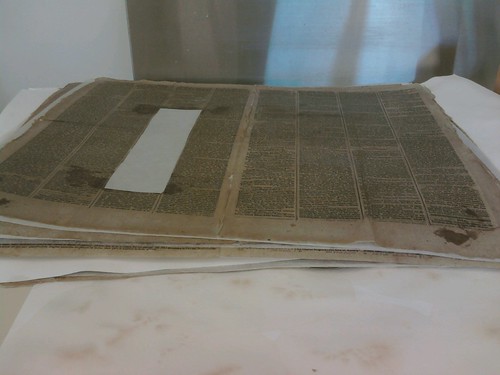
Finally, it's time to begin! Each folio is opened flat on a sheet of Hollytex and sprayed down with the filtered water (otherwise known as 'wetted-out') so that we don't shock the paper when it's introduced to the bath. Then, carefully, I grab the diagonal corners and dip the Hollytex and folio into the water. Slowly with my hands I "walk" from the edges of the paper toward the middle to allow the water to cover the folio completely. Once the folio is submerged we do it again! I keep piling them in until I run out of room or Hollytex, whichever comes first.
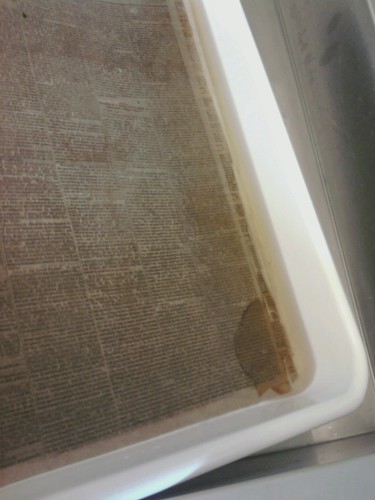
Now there are about 20 to 30 folios in one bath, I let it sit for about 7 minutes, after which I go back and stick my hands in and agitate the water. This simply means gently pressing the folios down and tapping lightly to move the water around in the bath and between each layer. Then I repeat one more time.
By now the water in the bath is getting a little dark, and that's not doing anyone any good. So by applying pressure to one corner of the stack I can hold them in place while I dump the water. After it's all poured out, I fill the bath back up but with just water this time. Let sit for 15 minutes, and now it's time to remove the items!
When there's glue involved it takes a little longer because for each issue I need to examine the fold and sometimes literally scrub the glue off. EWWW!!!
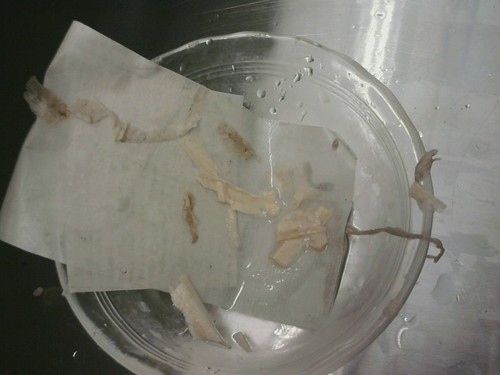
Or sometimes I have to put stuck text back in place. I've even had to peel off old repairs that are hindering rather than helping. Below is a sequence of photos showing the issue that is stuck to itself, making the text un-readable. I used my spatula to ease the chunk of text off one side and back to the other, eventually separating the two sides from one another.

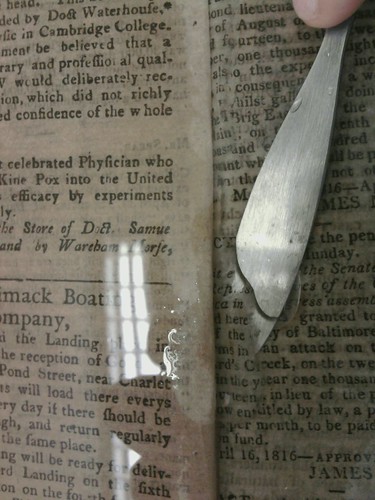

Once the issue has had alien items removed from it, I carefully grab hold of the paper and the Hollytex at one end and pull up slowly, making sure nothing loose is going to fall off. Once out of the water, I tip it a little to allow for the water to run off. I then place it on a piece of blotter, and pat it down with another piece of blotter. Then holding on to the diagonal corners again I can carry it to the drying rack. Repeat until everything is out and drying!
As I pass the torch of Blog Wrangler to Helen Bailey, dear readers, I just wanted to say 'Thank you' for a great run and keep tuning in. And that, my friends, is all she wrote.
Last Post Written by the one and only Beth Hetland

These have been very enjoyable Beth. Happy Trails!
ReplyDeleteThanks, capgemlib. We're glad you've enjoyed them!
ReplyDelete